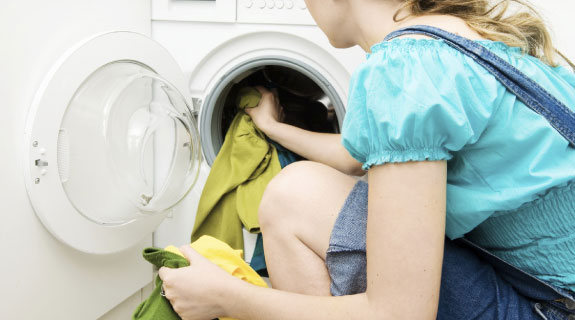Embrace that organic cotton t-shirt by all means, but being eco-chic is just as much about the way you care for your clothes as what you decide to buy. Annabel McAleer has a big bundle of green ideas that’ll lighten your laundry load—and save you time and money
Think you need to dress in organic, fair trade, vintage, hemp and bamboo gear to be eco-chic? Think again. It’s how you wash and dry your clothes that counts most—and it’s a heck of a lot cheaper than a new wardrobe. Here’s Good’s guide to better laundry. It’ll save you money and time, and leave your conscience as clean as your clothes.
A lot of things make smart shoppers think twice about buying new clothes: the environmental horrors of cotton production, the exploitation of foreign factory workers—and the eye-watering price tag on that gorgeous New Zealand-made dress.
Thinking a bit harder about the clothes we buy is undeniably important—but in the long run, what we do once we’ve worn them turns out to be just as important as where our glad rags were put together, or even what they’re made from.
Doing the weekly laundry generates more than just clean washing. The laundry uses about one-fifth of your household’s water, and according to one study, more than 80 percent of the carbon emissions produced during the life of a single top come from the energy used to clean and dry it. Even a cloth nappy, that eco-conscious badge of honour for forward-thinking parents, can have 81 percent more environmental impact than a disposable nappy if it’s always washed at 90°C and tumble-dried, according to the UK Environment Agency. The numbers suggest it’s time for re-think.
Less is more

Who says we need to wear freshly laundered clothes every day? Less than ten percent of the average wash is heavily soiled, one UK study found; much of the rest is crumpled-but-clean-ish stuff from the bedroom floor. Washing can fade, pill and stretch clothes, so if there’s no noticeable dirt or odour, consider it clean and wear it again! Here’s how to spend less time with your laundry:
I’ve just discovered soap nuts! Just four to six berries in a calico bag does a whole load of washing, and you can use these same berries several times. Soapnuts are 100 percent biodegradable (they go in the compost when you’re finished with them!), cheaper than commercial soaps, natural and gentle on your skin. Highly recommended! –Shirley Simmonds
Soak clothes in a large plastic bag in the sink. If anyone needs to use the sink, the bag can easily be removed without wasting the water. –Janet Luke
In summer and on windy days reduce the final spin speed on your washing cycle to reduce those ‘spun-in creases’ in your clothing. –Ellen Stewart
1 Don’t wash clothes you’ve only worn once. The ‘wear once and wash’ habit is easy to break: some garments will just need a spot clean, others can be refreshed by hanging in a steamy bathroom or on the line overnight.
2 Buy clothes in muted colours or patterns that won’t show marks.
3 Buy textured fabrics, which show less dirt.
4 Don’t buy clothes that need dry cleaning.
5 Don’t buy anything that must be hot washed.
6 Fold clothes straight off the line, to save ironing.
7 Keep a box for your gardening clothes. Unless you’re turning the compost or really working up a sweat you’ll often be able to wear them again.
8 Steam washing machines sometimes have a ‘refresh’ function, where clothes are tossed about with steam for 20 minutes or so, which removes odours and wrinkles without using as much energy as a full wash.
9 Folding is boring; avoid where possible. Hang up more clothes, roll up jeans and trousers, lay toddler’s clothes flat in the drawer or put in baskets, chuck gym clothes straight back in your bag. Fold the rest while chatting on the phone.
10 Spill something? Sponge it clean with cold water while you’re still wearing it.
11 Play 50s housewife (even if you’re a bloke) and wear a cute apron to cook in.
12 Kids will put stuff in the wash just so they don’t have to fold it. Make them responsible for folding their own clean washing off the line, and they might avoid putting it in the wash to begin with.
13 Alternatively, give them their own clean washing basket as well as a dirty one, so they have an easy place to toss once-worn and yet-to-be-put-away clothes.
Which eco-detergent is best?
14 For maximum environmental safety and the lowest levels of allergens, look for as many of these eco-claims as possible: No artificial fragrance, colours or preservatives; biodegradable; neutral PH; hypoallergenic; not tested on animals. Don’t buy detergent that contains phosphate, chlorine, ammonia, formaldehyde, petroleum solvents, optical brighteners, alcohol, butyl, glycol ether, SLS (sodium lauryl sulfate), SLES (sodium laureth sulfate) or EDTA (ethylenediaminetetraacetic acid). Phew!
15 Buy the biggest pack possible for less packaging to recycle; use the amount suggested on the label (or less); and go for concentrated detergents without unnecessary ‘filler’.
16 Look for third-party certification such as the Environmental Choice tick achieved by BEE laundry powder.
Put a piece of aluminium foil under the ironing board cover to reflect heat and make ironing faster. –Janet Luke

17 Alternatively, try non-detergent ways to clean your clothes. Switch to Washberry Soap Nuts (naturally soapy dried fruit), Eco Laundry Balls (reuseable mineral pellets) or EnviroDiscs (reusable ceramic beads) and do away with washing powder altogether.
18 Use Ecostore’s laundry liquid and you can safely use the grey water on the garden. Buy large containers directly from Ecostore ($67.50 for five litres) for the best price and least packaging.
Make a paste of baking soda and white vinegar and spread onto clothing stains. Use a pumice stone to gently rub the paste into the stain. Leave for half an hour, then wash. If the clothing is coloured then turn it inside out before using the pumice or just rub the material with the paste. –Kim Obrien
Make a clothes hamper using a man’s business shirt. Button up the front, sew the cuffs and bottom shut and hang on a hanger. Put dirty clothes in through the neck hole. –Janet Luke
I add half a scoop of baking soda to every scoop of laundry detergent for my whites and light colours in the washing machine. –Suzan Cherrie
Bleach is harmful to the environment. To whiten clothes add half a cup of borax to a normal wash then hang clothes in the sun. –Janet Luke
Smarter machines
Forget trees, we should all go and give our washing machines a hug. Thank goodness the days of the washboard are long-gone. And these brilliant timesaving appliances just keep getting better. Modern models use about half the energy and water of the average ten-year-old machine.
As a general rule, the more water a machine uses, the less efficient it is. Front-loading machines usually use less water than top-loaders, so they’re often more energy-efficient, even though they take longer to complete a wash. But some new models of top-loader offer the best of both worlds, cutting right back on water usage and speeding through a cycle.
New Zealand’s new water-efficiency labels and compulsory energy rating labels make it easy to compare machines (the more stars, the better), and blue Energy Star stickers identify the most energy-efficient appliances.
19 Pre-soak really dirty clothes, and eco-detergent and a cool wash temperature will often get ’em clean.
20 Heating water accounts for around 90 percent of the energy used to wash a load of clothes. Washing at 40°C uses half the energy of washing at 90°C. Cold water’s even better!
21 If you insist on washing in warm water, at least set the washing machine to do a cold water rinse.
22 Turn down the temperature on your hot water cylinder (60°C is ideal) to save energy anytime you use hot or warm water.
23 Fill the washing machine. Washing one large load uses less energy than washing two loads on a low or medium setting. (Don’t over-compensate though: over-fill the machine and your clothes won’t clean properly.)
24 Look at the annual kilowatt hours shown on the energy rating label when you buy a new washing machine: the cheapest machines are usually the most expensive to run, and will cost more over the next ten years.
25 If you wash in cold water, you don’t usually need to separate lights and darks, unless you’re washing something for the first time. Chuck it all in together and save yourself some hassle.
26 Use mesh washing bags for underwear and other delicates so you can add them to the main wash.
27 ‘Dryclean only’ labels are often just there to protect the manufacturer. Unless a garment is silk, beaded or made from an unusual fabric, it’s probably okay to handwash in lukewarm water.

28 Add a tablespoon of baking soda to the wash, along with your regular detergent; it’ll act as a fabric softener and colour-brightener.
29 If you do a load of laundry at night, it won’t be smelly by morning. Leave it there all day though, and you’ll need to wash it again.
Vinegar is good as a fabric softener, add half-a-cup to your rinse cycle. –Aaron Wells
When our clothes dryer died we made a conscious decision not to replace it. Instead we converted an old pergola into a drying room that, when not full of washing, makes a pleasant place to sit. I don’t miss my drier nor the electricity costs that came with it. –Nicki Brookes
Hang clothes overnight in frosty weather to bleach and starch them. –Janet Luke
Tumble dryer tricks
The most eco-friendly tumble dryer is the one you hardly use. If you can’t get by without one, make sure you get the most efficient on the market (look for that Energy Star) since dryers are one of the most power-hungry appliances out there.
The best dryers have built-in sensors that can tell when your washing is dry and turn the machine off. Drying clothes that are already dry is a huge waste of energy! Some new models work via heat pumps, drawing warm air from outside to heat the air in the dryer, using a heap less electricity than conventional dryers.
30 Give your clothes an extra spin in the washing machine if you need to put them in the dryer, to get rid of as much water as possible.
31 Or, take clothes out while ever-so-slightly damp, give ’em a shake and hang them up to finish drying. This will reduce the need for ironing, too.
32 Put a clean, dry towel in with each load of wet clothes. This will absorb initial moisture and your load will dry faster.
33 Use the auto-dry setting instead of the manual timer.
34 Dry similar types of fabric together: synthetics dry heaps faster than cotton and other natural fibres.

35 Clean the filter after every use for optimal performance. Every so often, vacuum the exhaust vent and inside the venting hose to clear out lint.
36 Doing two or more loads in a row will take advantage of heat still in the dryer from the previous load.
37 It’s still best to do one full load if possible, but don’t overfill the dryer or it will take longer to do its job. And don’t add wet gear to a load that’s already partly dried!
38 Hang heavy, slow-drying clothes such as towels on a rack for a day or two, then finish off with a short spin if necessary.
39 If you have an older machine without a sensor, set the timer for less time than you think each load might need, then check to see whether it needs an extra burst. If your machine has a cool-down setting, use that to finish off.

Hang clothes out to dry as soon as the wash cycle finishes. Give each piece a good flick and hang it up tidily—peg just under the armpits on t-shirts. Fold your washing as you remove it from the line and you’ll eliminate many items from the ironing pile. –Ellen Stewart
We bought some washing line and have hung it up in our garage. Now when it rains, winter or summer, we hang the clothes in the garage. It takes a little longer to dry than on the line, but works really well.
–Virginia Lang
Cleverness at the clothesline
40 Plant delicious smelling ground-cover herbs such as thyme underneath your clotheslines, so fragrance is released when you stand on the plants to hang your washing.
41 The sun can help remove stains (it’s the only way to get rid of lily pollen) and kill bacteria, so it’s ideal to sun-dry nappies.
42 Put up a ‘spare’ clothesline under cover in the garage, carport or laundry, for drying overnight or on damp days.
43 Dry your clothes outside whenever possible. If it looks like it could rain, put them on a clotheshorse outside so you can bring them in as soon as it starts spitting—and you won’t have to re-hang them once the rain stops.
44 If you use a clotheshorse inside, keep it in a sunny area away from main living rooms. Moisture from the clothes can increase humidity, which makes the air harder to heat. If you live in an already-damp house or a family member is asthmatic, avoid drying clothes indoors.
Get sorted
45 Get clever with space in your laundry: mount the dryer on the wall and add as much shelving as possible. Use baskets to store cleaning products and other practical items such as a shoe polishing kit, your picnic basket, sports gear, blankets, beach towels, even the kids’ dress-up box.
46 Attach a pull-out clothes rack or line to your laundry wall, and string rows of cord on the door of your hot water cupboard for drying delicates. Use hooks on the door or wall to store your drying rack, ironing board, mop, broom and even rain jackets.
47 Make a laundry schedule for the week, such as sheets and towels on Monday, dark clothes on Wednesday and lights on Friday, and leave your weekends free.
The future of your laundry

Futuristic washing machines are already here. Sanyo Electric’s waterless washing machines are on sale now in Japan and Taiwan. The ironically named ‘Aqua’ machine uses a process called ozonation to air-wash clothes with oxygen, removing bacteria and most stains without a drop of water. It uses more energy than a water wash, but clothes don’t need drying afterwards, so the machine is said to use about 20 percent less energy than a wash plus tumble dry. This new tech doesn’t come cheap: the Aqua machine costs about 80 percent more than other washer-dryers.
Another machine in development in the UK uses just one cup of water, tossing clothes about with small, reusable polymer beads to get them clean. Sounds unlikely, but it works, even removing lipstick and coffee stains.
Steam machines are another recent development. They cut down on water consumption by using steam in the wash. They can have long washing cycles, however, so check the energy rating label for power consumption. The new Bosch Classic has a 15-minute express wash and an eco program for cotton.
The shortest complete wash cycle is delivered by British brand Beko, whose Xpress Washing Machine (above) can do a full load of washing in just 28 minutes, using the exact amount of water required. It’s already on sale in the UK, at a comparable price to a regular washing machine.
Another technology we’re sure to see more of is greywater recycling. These systems collect used water from the washing machine and shower, and use it for flushing the toilet or watering the garden, saving around 30 percent of an average home’s water consumption.
Make your own laundry powder
Good reader Cathy Agnew wrote in to share her simple, inexpensive recipe:
It takes 10-15 minutes to make and lasts for at least 6 weeks because you only use 1 tablespoon per load (yes, that’s correct, only 1 tablespoon!) I work full time in a demanding job so don’t have the time or interest in complicated recipes, which is why this appealed to me! I’d suggest you buy a cheap food processor to blend up the soap powder (I got one through TradeMe for $20) so it doesn’t taint your kitchen food processor.
Washing Powder
125 grams powderised/grated sunlight soap
1kg washing soda or soda ash (I purchased soda ash through TradeMe)
Cut soap up first and powderise both ingredients in a food processor. Use 1 tablespoon per wash.





